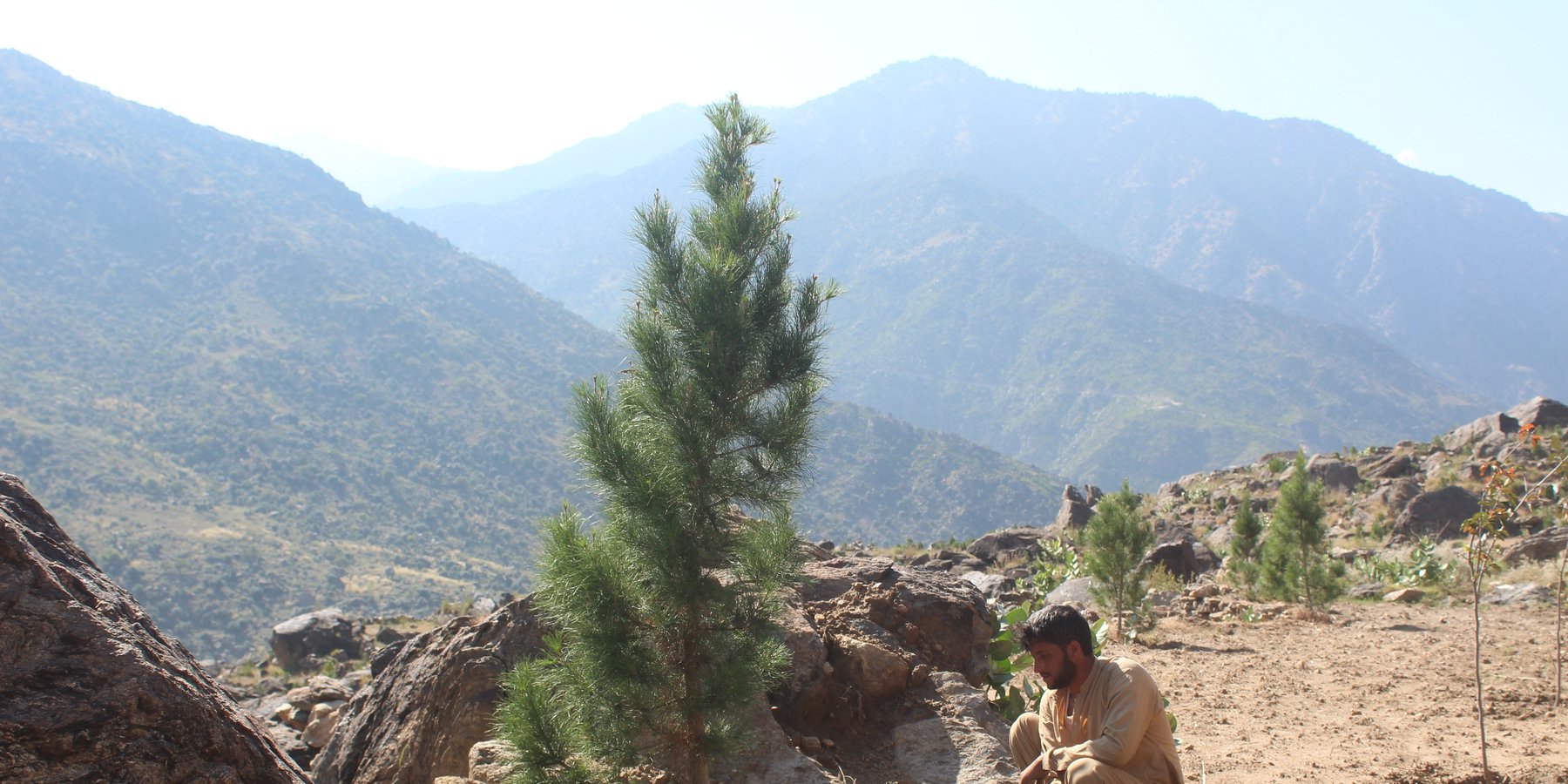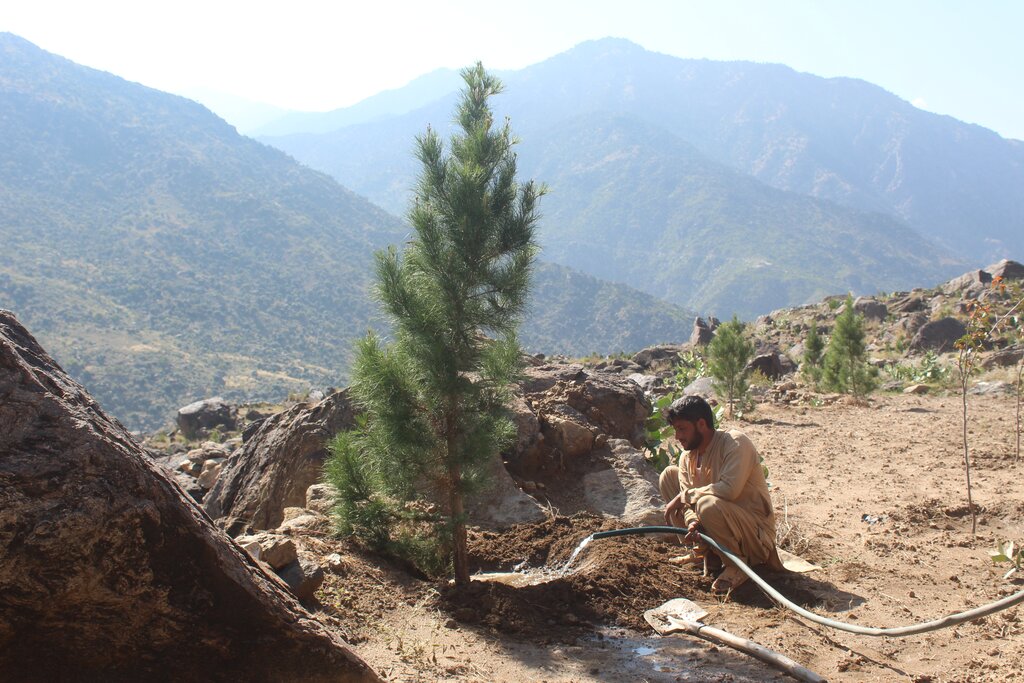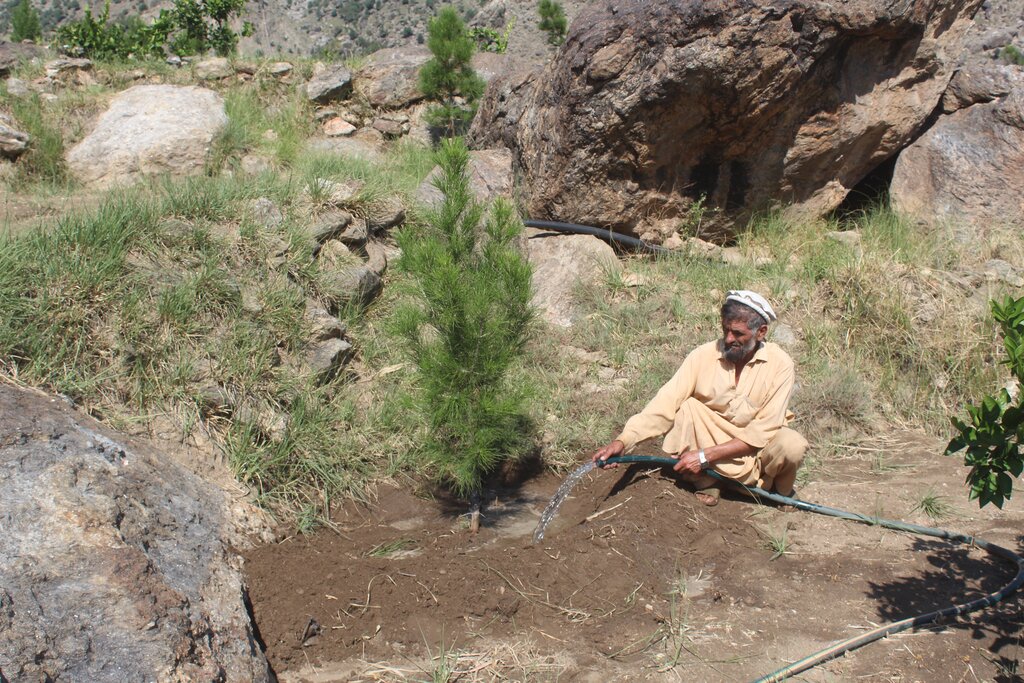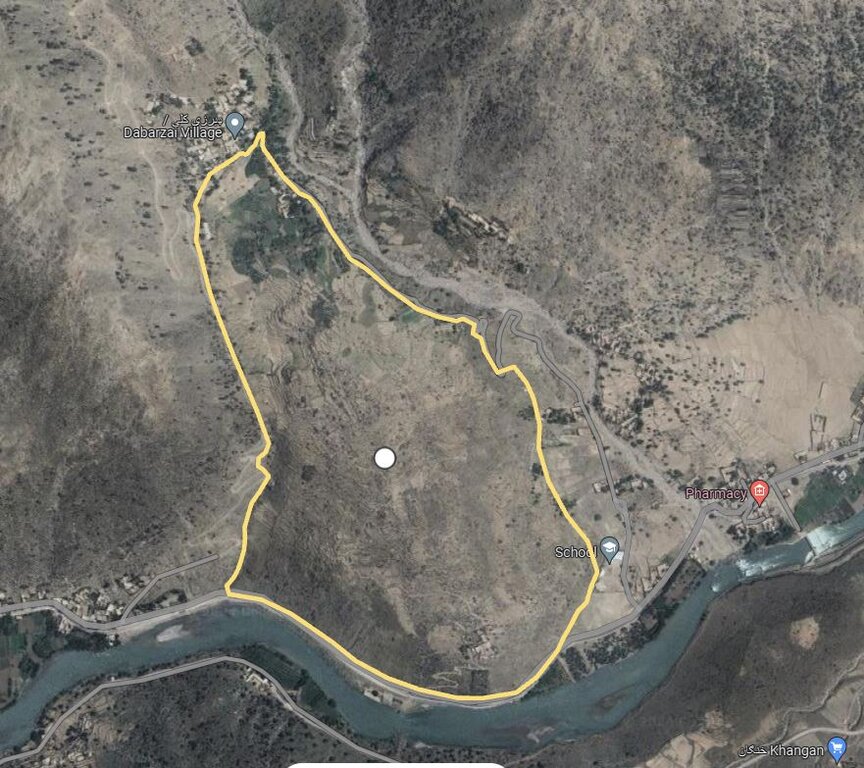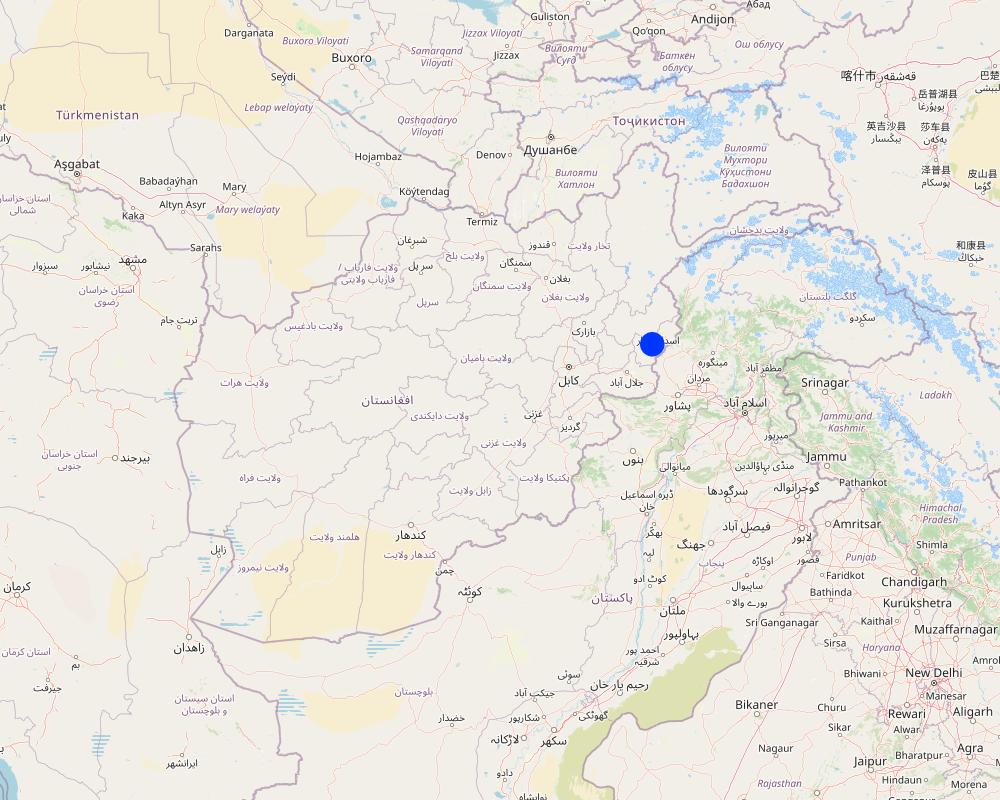Using lift irrigation for afforestation and agroforestry in Kunar [ອັຟການີດສະຖານ]
- ການສ້າງ:
- ປັບປູງ:
- ຜູ້ສັງລວມຂໍ້ມູນ: Ahmad Khalid Wiyar
- ບັນນາທິການ: Megha bajaj, Mohammad Ajmal Rahimy, Mir Wali Khan Lakanwal
- ຜູ້ທົບທວນຄືນ: Rima Mekdaschi Studer, Illias Animon, Muhammad Ishaq Safi
د ځنګل رغونی او کرنیزی ځنګلداری لپاره د پمپ په واسطه د ابه خور سیستم
technologies_7473 - ອັຟການີດສະຖານ
- ສະຫຼຸບສັງລວມຢ່າງທັງໝົດທີ່ເປັນ PDF
- ສັງລວມເປັນບົດ PDF ເພື່ອສັ່ງພິມ
- ສັງລວມເປັນບົດ ຢູ່ໃນ browser
- ບົດສະຫຼຸບ ສະບັບເຕັມ (ບໍ່ມີແບບຟອມ)
- Using lift irrigation for afforestation and agroforestry in Kunar: March 5, 2025 (inactive)
- Using lift irrigation for afforestation and agroforestry in Kunar: March 24, 2025 (inactive)
- Using lift irrigation for afforestation and agroforestry in Kunar: May 18, 2025 (inactive)
- Using lift irrigation for afforestation and agroforestry in Kunar: July 9, 2025 (public)
ເບິ່ງພາກສ່ວນ
ຂະຫຍາຍທັງໝົດ ຍຸບທັງໝົດ1. ຂໍ້ມູນທົ່ວໄປ
1.2 ຂໍ້ມູນ ການຕິດຕໍ່ພົວພັນ ຂອງບຸກຄົນທີ່ສໍາຄັນ ແລະ ສະຖາບັນ ທີ່ມີສ່ວນຮ່ວມ ໃນການປະເມີນເອກກະສານ ເຕັກໂນໂລຢີ
ບັນດາຜູ້ຕອບແບບສອບຖາມທີ່ສໍາຄັນ ()
ຜຸ້ຊ່ຽວຊານ ດ້ານການຄຸ້ມຄອງ ທີ່ດິນແບບຍືນຍົງ:
Safi Sharifullah
Food and Agriculture Organization of the United Nations
ອັຟການີດສະຖານ
ຜູ້ນໍາໃຊ້ທີ່ດິນ:
Safi Mohammad Afzal
Managi Forest Management Association (FMA)
ອັຟການີດສະຖານ
ຜູ້ນໍາໃຊ້ທີ່ດິນ:
Safi Qiamuddin
Managi Forest Management Association (FMA)
ອັຟການີດສະຖານ
ຜູ້ນໍາໃຊ້ທີ່ດິນ:
Safi Farhad
Managi Forest Management Association (FMA)
ອັຟການີດສະຖານ
ຊື່ໂຄງການ ທີ່ອໍານວຍຄວາມສະດວກ ໃນການສ້າງເອກກະສານ/ປະເມີນ ເຕັກໂນໂລຢີ (ຖ້າກ່ຽວຂ້ອງ)
Community-based sustainable land and forest management in Afghanistanຊື່ສະຖາບັນ (ຫຼາຍສະຖາບັນ) ທີ່ອໍານວຍຄວາມສະດວກ ໃນການສ້າງເອກກະສານ / ປະເມີນ ເຕັກໂນໂລຢີ (ຖ້າກ່ຽວຂ້ອງ)
FAO Afghanistan (FAO Afghanistan) - ອັຟການີດສະຖານ1.3 ເງື່ອນໄຂ ກ່ຽວກັບ ການນໍາໃຊ້ຂໍ້ມູນເອກະສານ ທີ່ສ້າງຂື້ນ ໂດຍຜ່ານ ອົງການພາບລວມຂອງໂລກ ທາງດ້ານແນວທາງ ແລະ ເຕັກໂນໂລຢີ ຂອງການອານຸລັກ ທໍາມະຊາດ (WOCAT)
ຜູ້ປ້ອນຂໍ້ມູນ ແລະ ບຸກຄົນສຳຄັນ ທີ່ໃຫ້ຂໍ້ມູນ (ຫຼາຍ) ຍິນຍອມ ຕາມເງື່ອນໄຂ ໃນການນຳໃຊ້ຂໍ້ມູນ ເພື່ອສ້າງເປັນເອກກະສານຂອງ WOCAT:
ແມ່ນ
1.4 ແຈ້ງການວ່າ ດ້ວຍຄວາມຍືນຍົງຂອງ ເຕັກໂນໂລຢີ
ການນໍາໃຊ້ ເຕັກໂນໂລຢີ ດັ່ງກ່າວໄດ້ອະທິບາຍ ເຖິງບັນຫາ ກ່ຽວກັບ ການເຊື່ອມໂຊມຂອງດິນບໍ? ຖ້າບໍ່ດັ່ງນັ້ນ ມັນບໍ່ສາມາດ ຢັ້ງຢືນໄດ້ວ່າ ເປັນເຕັກໂນໂລຊີ ໃນການຄຸ້ມຄອງ ທີ່ດິນແບບຍືນຍົງ? :
ບໍ່ແມ່ນ
ຄວາມຄິດເຫັນ:
No, the technology described here is not problematic with regard to land degradation. In fact, it promotes sustainable land management by enhancing soil health, preventing erosion, and supporting afforestation efforts. This technology contributes to the restoration and conservation of forest ecosystems.
2. ການອະທິບາຍ ເຕັກໂນໂລຢີ ຂອງການຄຸ້ມຄອງ ທີ່ດິນແບບຍືນຍົງ
2.1 ຄໍາອະທິບາຍສັ້ນຂອງ ເຕັກໂນໂລຢີ
ການກຳໜົດຄວາມໝາຍ ຂອງເຕັກໂນໂລຢີ:
Water exploitation is a major issue in Afghanistan. The lift irrigation technology helps to irrigate an afforestation/agroforestry area (demonstration plot) using surface water (rivers) and solar-powered submersible pump. The construction of reservoirs at the demo plot ensures efficient water storage and use for irrigation purposes without relying on groundwater. A well-designed pipe irrigation scheme is implemented to distribute water evenly across the site, supporting plant irrigation and growth.
2.2 ການອະທິບາຍ ລາຍລະອຽດ ຂອງເຕັກໂນໂລຢີ
ການພັນລະນາ:
Water exploitation is a critical issue in Afghanistan, and the project aims to address this challenge through innovative and sustainable technology. The technology involves the use of solar panels and submersible water pumps to efficiently lift water from a nearby river to reservoirs constructed uphill, which is then distributed by gravity with the help of a pipe system to irrigate planted saplings in the afforested and agroforestry area. For afforestation, Pinus eldarica (Afghan pine) was planted due to its adaptability and soil stabilization properties. Additionally, citrus and persimmon trees are introduced for agroforestry, combining tree cultivation with agricultural benefits. This integrated technology promotes biodiversity, soil health, and sustainable land use, making the site a model/ demonstration site for afforestation and agroforestry practices. This is a significant advancement in the local area, utilizing clean energy to promote sustainable land and forest management and environmental restoration. The project is implemented on communal land, covering 50.25 hectares of land.
The primary purpose of this technology is to create an efficient irrigation system that extracts and transports water to support afforestation and agroforestry activities. By doing so, it aims to restore forest cover, mitigate environmental challenges such as land degradation, and promote long-term ecological and socio-economic sustainability. The technology includes key components such as solar panels, water pumps (submersible), polyvinyl chloride (PVC) pipes, water reservoirs, and saplings. Additionally, it requires labor, technical assistance, capacity-building programs, and construction materials for its establishment and maintenance.
The benefits of this technology are substantial. It has successfully irrigated previously barren land, achieving an impressive 85% survival rate for the saplings that were planted in the plot, while preventing land degradation and improving soil health. Without this technology, survival rates would drop to zero due to the arid conditions. Furthermore, the project has enhanced the capacities of local farmers/community members, enabling them to replicate and demonstrate the technology within their community. This has fostered a sense of ownership and empowerment among land users.
Land users have expressed both appreciation and concerns regarding the technology. On the positive side, they value its efficiency and reliability, as the solar panels provide a consistent water supply, especially during the hot/sunny season, leading to increased greenery and healthier trees. The cost-effectiveness of solar energy, with its low operational costs compared to traditional diesel pumps, has also been a significant advantage. Additionally, the environmentally friendly nature of the technology aligns with their desire for sustainable practices. The capacity-building programs provided by organizations like FAO have further empowered users to manage the system effectively.
However, some challenges have been noted. The initial investment costs for purchasing, installing and construction of the technology are high, making it difficult for smallholder farmers to replicate. Technical issues, such as inverter failures or battery malfunctions during extreme weather conditions (e.g., cloudy weather), can disrupt operations. Additionally, not all community members are equally informed about the technology’s benefits, highlighting the need for increased outreach and engagement efforts to ensure broader adoption and understanding.
In summary, this solar-powered irrigation technology represents a groundbreaking innovation in the area, combining clean energy with sustainable land management practices. While it has demonstrated significant environmental and agricultural benefits, addressing the challenges of initial costs, technical reliability, and community engagement will be crucial for its long-term success and scalability.
2.3 ຮູບພາບຂອງເຕັກໂນໂລຢີ
2.4 ວິດີໂອ ເຕັກໂນໂລຢີ
ສະຖານທີ່:
N/A
ຊື່ຂອງຜູ້ຖ່າຍວີດີໂອ:
N/A
2.5 ປະເທດ / ເຂດ / ສະຖານທີ່ບ່ອນທີ່ ເຕັກໂນໂລຢີ ໄດ້ຮັບການນໍາໃຊ້ ແລະ ທີ່ຖືກປົກຄຸມດ້ວຍການປະເມີນຜົນ
ປະເທດ:
ອັຟການີດສະຖານ
ພາກພື້ນ / ລັດ / ແຂວງ:
Kunar
ຂໍ້ມູນເພີ່ມເຕີມຂອງສະຖານທີ່:
Managi village of Manogi district
ໃຫ້ລະບຸ ການແຜ່ຂະຫຍາຍ ເຕັກໂນໂລຢີ:
- ນໍາໃຊ້ໃນຈຸດສະເພາະ / ແນໃສ່ນໍາໃຊ້ໃນພື້ນທີ່ຂະໜາດນ້ອຍ
ສ່ວນຫຼາຍສະຖານທີ່ຕັ້ງຂອງເຕັກໂນໂລຢີ ແມ່ນ ຢູ່ໃນເຂດພື້ນທີ່ສະຫງວນບໍ?
ບໍ່ແມ່ນ
ຄວາມຄິດເຫັນ:
The area is about 50.25 ha, and the coordinate has been taken from the center of the site, where technology has been implemented:
34.9419930°N71.0119714°E
Map
×2.6 ວັນທີໃນການຈັດຕັ້ງປະຕິບັດ
ໃຫ້ລະບຸປີ ໃນການຈັດຕັ້ງປະຕິບັດ:
2022
2.7 ການນໍາສະເໜີ ເຕັກໂນໂລຢີ
ໃຫ້ລະບຸ ເຕັກໂນໂລຢີ ໄດ້ຖືກຈັດຕັ້ງປະຕິບັດຄືແນວໃດ?
- ໂດຍຜ່ານໂຄງການ / ການຊ່ວຍເຫຼືອຈາກພາຍນອກ
ຄວາມຄິດເຫັນ (ປະເພດ ໂຄງການ ແລະ ອື່ນໆ):
GEF-06 Community based Sustainable Land and Forest Management in Afghanistan
3. ການໃຈ້ແຍກ ເຕັກໂນໂລຢີ ໃນການຄຸ້ມຄອງ ດິນແບບຍືນຍົງ
3.1 ຈຸດປະສົງຫຼັກ (ຫຼາຍ) ຂອງເຕັກໂນໂລຢີ
- ປັບປຸງ ການຜະລິດ
- ຫຼຸດຜ່ອນ, ປ້ອງກັນ, ຟື້ນຟູ ການເຊື່ອມໂຊມຂອງດິນ
- ປັບຕົວຕໍ່ກັບການປ່ຽນແປງດິນຟ້າອາກາດ / ທີ່ຮ້າຍແຮງ ແລະ ຜົນກະທົບ
- ສ້າງຜົນກະທົບ ທາງເສດຖະກິດ ທີ່ເປັນປະໂຫຍດ
3.2 ປະເພດການນໍາໃຊ້ທີ່ດິນ ໃນປະຈຸບັນ() ທີ່ເຕັກໂນໂລຢີ ໄດ້ຖືກນໍາໃຊ້
ການນຳໃຊ້ທີ່ດິນ ປະສົມພາຍໃນພື້ນທີ່ດຽວກັນ:
ແມ່ນ
ລະບຸການນຳໃຊ້ທີ່ດິນແບບປະສົມ (ຜົນລະປູກ / ທົ່ງຫຍ້າລ້ຽງສັດ / ຕົ້ນໄມ້):
- ກະສິກໍາ-ປ່າໄມ້ ແບບປະສົມປະສານ

ດິນທີ່ປູກພືດ
- ເປັນໄມ້ຢືນຕົ້ນ ແລະ ໄມ້ພຸ່ມ ຈາກການປູກພືດ
ການປູກພືດທີ່ເປັນຕົ້ນໄມ້ ແລະ ໄມ້ພຸ່ມ - ລະບຸປະເພດພືດ:
- ໝາກນາວ
- Persimmon
ຈໍານວນ ລະດູການ ປູກໃນປີໜຶ່ງ:
- 1
ມີການເຝືກປູກພືດແບບສັບຫວ່າງບໍ່?
ບໍ່ແມ່ນ
ມີການເຝືກປູກພືດແບບໝູນວຽນບໍ່?
ບໍ່ແມ່ນ

ປ່າໄມ້ / ປ່າ
- ການປູກຕົ້ນໄມ້, ການປູກປ່າ
ການປູກຕົ້ນໄມ້, ປູກປ່າ: ລະບຸ ຕົ້ນກຳເນີດ ແລະ ອົງປະກອບ ຂອງສາຍພັນ:
- ການປູກໄມ້ ແນວພັນພື້ນເມືອງ ຊະນິດດຽວ
ປະເພດຕົ້ນໄມ້, ປ່າທີ່ປູກ:
- ການປູກໄມ້ໃກ້ປ່າແຫ້ງເຂດຮ້ອນ - ໝາກກໍ່
ປະເພດຂອງຕົ້ນໄມ້:
- Pinus species (pine)
ຕົ້ນໄມ້ທີ່ຖືກລະບຸຢູ່ຂ້າງເທິງ ເປັນປ່າຜັດປ່ຽນໃບ ຫລື ປ່າດົງດິບ?
- ປ່າດົງດິບ
ຜົນຜະລິດ ແລະ ການບໍລິການ:
- ການອະນຸລັກທໍາມະຊາດ / ການປ້ອງກັນ
- ນັນທະນາການ / ການທ່ອງທ່ຽວ
- ປ້ອງກັນ ການຄຸກຄາມ ທາງທໍາມະຊາດ
3.3 ການນຳໃຊ້ທີ່ດິນ ມີການປ່ຽນແປງຍ້ອນການຈັດຕັ້ງທົດລອງເຕັກໂນໂລຢີ ແມ່ນບໍ່?
ການນຳໃຊ້ທີ່ດິນ ມີການປ່ຽນແປງຍ້ອນການຈັດຕັ້ງທົດລອງເຕັກໂນໂລຢີ ແມ່ນບໍ່?
- ແມ່ນ (ກະລຸນາຕື່ມໃສ່ ຄຳຖາມຂ້າງລຸ່ມນີ້ກ່ຽວກັບການນຳໃຊ້ທີ່ດິນ ກ່ອນການທົດລອງເຕັກໂນໂລຢີ)
ການນຳໃຊ້ທີ່ດິນ ປະສົມພາຍໃນພື້ນທີ່ດຽວກັນ:
ບໍ່ແມ່ນ
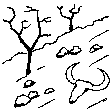
ດິນ ທີ່ບໍ່ອຸດົມສົມບູນ
ລະບຸ ຊະນິດ:
5 decades ago, the area was a forest area, but due to war, smuggling and drought the area become barren land.
3.4 ການສະໜອງນ້ຳ
ການສະໜອງນໍ້າ ໃນພື້ນທີ່ ທີ່ໄດ້ນໍາໃຊ້ ເຕັກໂນໂລຢີ:
- ປະສົມປະສານ ກັນລະຫວ່າງ ນໍ້າຝົນ ແລະ ນໍ້າຊົນລະປະທານ
ຄວາມຄິດເຫັນ:
The saplings planted in the area have been supplementary irrigated. Prior to the implementation of this technology, the land was barren, and seasonal rains led to soil erosion.
3.5 ການນໍາໃຊ້ເຕັກໂນໂລຢີ ທີ່ຢູ່ໃນກຸ່ມການຄຸ້ມຄອງ ທີ່ດິນແບບຍືນຍົງ
- ການຄຸ້ມຄອງການປູກປ່າ
- ການປັບປຸງດິນ / ພືດຄຸມດິນ
- ປະສິດທິພາບ ເຕັກໂນໂລຢີ ການນຳໃຊ້ພະລັງງານ
3.6 ມາດຕະການ ການຄຸ້ມຄອງ ທີ່ດິນແບບຍືນຍົງ ປະກອບດ້ວຍ ເຕັກໂນໂລຢີ

ມາດຕະການ ທາງດ້ານພືດພັນ
- V1: ເປັນໄມ້ຢືນຕົ້ນ ແລະ ການປົກຫຸ້ມຂອງໄມ້ພຸ່ມ

ມາດຕະການໂຄງສ້າງ
- S5: ເຂື່ອນໄຟຟ້າ, ຝາຍເກັບນໍ້າ, ອ່າງ, ໜອງ
- S7: ອຸປະກອນເກັບຮັກສາ, ສະໜອງນ້ຳ, ຊົນລະປະທານ
- S10: ມາດຕະການ ປະຢັດພະລັງງານ

ມາດຕະການ ທາງດ້ານການຄຸ້ມຄອງ
- M1: ການປ່ຽນແປງ ປະເພດ ການນໍາໃຊ້ທີ່ດິນ
- M3: ອີງຕາມສະພາບແວດລ້ອມ ທາງທຳມະຊາດ ແລະ ມະນຸດ
ຄວາມຄິດເຫັນ:
The project has successfully implemented afforestation by planting trees and promoting agroforestry through the cultivation of fruit trees. To improve irrigation management, the project installed a 1-inch underground pipeline system with connected taps, enabling the attachment of flexible hoses. This efficient setup ensures optimal watering of saplings while significantly reducing water waste. By implementing this approach, the project has enhanced vegetative cover and successfully planted approximately 32,000 saplings. Additionally, the project constructed 14 rotating mounting structures for solar panels, installed 134 solar panels, established pipe schemes for manual irrigation of saplings, and constructed 6 water reservoirs with different capacities. The integration of trees at optimal spacing, combined with regular cultural practices, has further supported the project's goals.
3.7 ປະເພດດິນເຊື່ອມໂຊມ ຫຼັກທີ່ໄດ້ນໍາໃຊ້ ເຕັກໂນໂລຢີ

ດິນເຊາະເຈື່ອນ ໂດຍນໍ້າ
- Wt: ການສູນເສຍຊັ້ນໜ້າດິນ / ການເຊາະເຈື່ອນຜິວໜ້າດິນ

ການເຊື່ອມໂຊມ ທາງຊີວະພາບ
- Bc: ການຫຼຸດຜ່ອນການປົກຫຸ້ມຂອງພືດ
- Bh: ການສູນເສຍ ທີ່ຢູ່ອາໃສ ຂອງສິ່ງທີ່ມີຊິວິດ
- Bl: ການສູນເສຍ ຈຸລິນຊີໃນດິນ

ການເຊື່ອມໂຊມ ຂອງນໍ້າ
- Ha: ສະພາບແຫ້ງແລ້ງ
- Hg: ການປ່ຽນແປງ ລະດັບນ້ຳໃຕ້ດິນ ຫຼື ນ້ຳບາດານ
ຄວາມຄິດເຫັນ:
The planting pits are specially designed for planting of saplings. Additionally, farmers construct small barriers near plants (eye-brows and trenches), known as micro-catchments, to collect and retain water. It is important to note that these micro-catchments are distinct structures, separate from pits and reservoirs, and are specifically built to support water retention for plants. The enhanced vegetation cover and the establishment of micro-catchments for water collection significantly reduce soil erosion. Soil improvement and enrichment, as well as habitat enhancement, are supported through these practices. Additionally, they contribute to groundwater recharge and help control runoff.
3.8 ການປ້ອງກັນ, ການຫຼຸດຜ່ອນ, ຫຼືການຟື້ນຟູຂອງການເຊື່ອມໂຊມຂອງດິນ
ໃຫ້ລະບຸ ເປົ້າໝາຍ ເຕັກໂນໂລຢີ ທີ່ພົວພັນ ກັບຄວາມເຊື່ອມໂຊມຂອງດິນ:
- ປ້ອງກັນການເຊື່ອມໂຊມຂອງດິນ
- ການຟື້ນຟູ / ຟື້ນຟູດິນທີ່ຊຸດໂຊມ
ຄວາມຄິດເຫັນ:
The human-induced causes of land degradation include deforestation, overgrazing of livestock, and unsustainable agricultural practices. In response, following the implementation of a specific technology, local communities established regulations rooted in their customs and traditions to protect the site, which is quarantined for five years. These regulations prohibit herders from grazing animals, cutting trees, engaging in unsustainable agricultural practices, and uprooting bushes for fuelwood. Additionally, the community has constructed rainwater harvesting structures, such as eyebrows and trenches, across the site to address natural causes of land degradation through runoff by enhancing water infiltration. As a result, the site is now effectively protected from both human-induced and natural land degradation.
4. ຂໍ້ກໍາໜົດ, ກິດຈະກໍາການປະຕິບັດ, ວັດຖຸດິບ, ແລະຄ່າໃຊ້ຈ່າຍ
4.1 ເຕັກນິກ ໃນການແຕ້ມແຜນວາດ ເຕັກໂນໂລຢີ
ຄຸນລັກສະນະ ຂອງເຕັກນິກ (ທີ່ກ່ຽວຂ້ອງ ກັບການແຕ້ມແຜນວາດ ທາງດ້ານເຕັກນີກ):
According to the technical specifications from the project engineer, 6 reservoirs have been constructed with varying dimensions and water holding capacities as follows:
1.First reservoir: Dimension of 12x6x2 meters, with a water holding capacity of 144 m³.
2.Central reservoir: Dimensions of 16x8x2 meters, with a water holding capacity of 256 m³.
3.Four additional reservoirs: Each measuring 10x5x2 meters, with a water holding capacity of 100 m³
In total, the reservoirs will hold 800 m³ of water, ensuring a reliable water supply for irrigation of the area. Two 2-inch submersible pumps draw water from the river to supply the first reservoir. From there, two additional 2-inch submersible pumps transfer water from the first reservoir to the central reservoir. The water then flows to the other four reservoirs by gravity.
Furthermore, excavation and backfilling for 2-inch polyethylene pipes should be done to a depth of 80 cm with a width of 50 cm. For 1.5-inch pipes, excavation and backfilling should be 40 cm deep. The installation of 1.5-inch polyethylene pipes, including all elbows, joints, connectors, and valves, should be carried out every 30 meters on both sides, connecting to 1-inch pipes, in accordance with specifications and to satisfaction.
Additionally, 32,000 Pinus eldarica (Afghan Pine) and 2,500 citrus and persimmon saplings were planted across 50.25 hectares of degraded land. The saplings are spaced 5 meters apart, both plant-to-plant and row-to-row, as part of afforestation and agroforestry initiatives. This effort aims to restore ecosystems, enhance biodiversity, and improve soil conservation.
ຜູ້ຂຽນ:
Hafizullah Naeemy
ວັນທີ:
01/03/2022
4.2 ຂໍ້ມູນທົ່ວໄປກ່ຽວກັບການຄິດໄລ່ປັດໃຈຂາເຂົ້າໃນການຜະລິດ ແລະ ມູນຄ່າອື່ນໆ
ລະບຸ ວິທີການ ຄຳໃຊ້ຈ່າຍ ແລະ ປັດໄຈນໍາເຂົ້າ ທີ່ໄດ້ຄິດໄລ່:
- ຕໍ່ພື້ນທີ່ ທີ່ໄດ້ຈັດຕັ້ງປະຕິບັດ ເຕັກໂນໂລຢີ
ໃຫ້ລະບຸຫົວໜ່ວຍ ຂະໜາດ ແລະ ເນື້ອທີ່:
50.25 Hectares
ລະບຸ ສະກຸນເງິນທີ່ໃຊ້ສໍາລັບ ການຄິດໄລ່ຄ່າໃຊ້ຈ່າຍ:
- USA
ລະບຸ ຄ່າຈ້າງ ຄ່າແຮງງານສະເລ່ຍ ຕໍ່ ວັນ:
5 USD
4.3 ການສ້າງຕັ້ງກິດຈະກໍາ
| ກິດຈະກໍາ | Timing (season) | |
|---|---|---|
| 1. | Awareness and mobilization of the community | Aug-2021 |
| 2. | Survey and site selection followed by feasibility study | Sep to Oct-2021 |
| 3. | Stakeholder consultation | Aug-2021 till Sep-2022 |
| 4. | Preparation of technical design, drawings, and Bill of Quantities (BoQ). | Nov to Dec-2021 |
| 5. | Initiation of procurement process for required tools and equipment | Jan to Feb-2022 |
| 6. | Excavation and construction of water reservoirs, setting up pipe system and installation of solar panels for irrigation. | Mar to Sep-2022 |
| 7. | Capacity building of the target communities | Aug- 2021 till date |
| 8. | Practical interventions: production or purchase of saplings, digging planting pits, transplatation and irrigation of saplings and establishment of micro-catchments | Feb to Mar-2023 |
ຄວາມຄິດເຫັນ:
The awareness-raising session on Sustainable Land Management (SLM) and Sustainable Forest Management (SFM) was successfully held to improve understanding of land and forest management practices and conservation efforts. Community members were actively mobilized to support the project, aiding in the completion of construction and installation work.
4.4 ຕົ້ນທຶນ ແລະ ປັດໄຈຂາເຂົ້າທີ່ຈໍາເປັນໃນຈັດຕັ້ງປະຕິບັດ
| ລະບຸ ປັດໃຈ ນໍາເຂົ້າ ໃນການຜະລີດ | ຫົວໜ່ວຍ | ປະລິມານ | ຕົ້ນທຶນ ຕໍ່ຫົວໜ່ວຍ | ຕົ້ນທຶນທັງໝົດ ຂອງປັດໃຈຂາເຂົ້າ ໃນການຜະລິດ | % ຂອງຕົ້ນທຶນທັງໝົດ ທີ່ຜູ້ນໍາໃຊ້ທີ່ດິນ ໃຊ້ຈ່າຍເອງ | |
|---|---|---|---|---|---|---|
| ແຮງງານ | Unskilled labor for planting of saplings | Man/day | 450.0 | 5.0 | 2250.0 | 100.0 |
| ແຮງງານ | Skilled labor for installation of irrigation system and constuction of reservoirs | Man/day | 50.0 | 10.0 | 500.0 | |
| ອຸປະກອນ | Water Pump 2 inch - 10HP/7500w | Number | 4.0 | 450.0 | 1800.0 | |
| ອຸປະກອນ | Solar Panel minimum size 400W and 270W | Number | 132.0 | 82.0 | 10824.0 | |
| ອຸປະກອນ | DC to AC Inverter 7.5-11KW | Number | 4.0 | 450.0 | 1800.0 | |
| ອຸປະກອນ | Polyethylene Pipes 2 Inch and 1.5 Inch with all elbows, joints, connectors and valves after 30 meter for both sides to connect pipes. | Meter | 4300.0 | 2.75 | 11825.0 | |
| ອຸປະກອນ | Rotating PV panels mounting structure (manual) | Number | 28.0 | 270.0 | 7560.0 | |
| ອຸປະກອນ | DC and AC current wire | Meter | 1800.0 | 2.5 | 4500.0 | |
| ອຸປະກອນ | Distribution board | Number | 2.0 | 70.0 | 140.0 | |
| ອຸປະກອນ | Flexon 1 inch rubberize pipes | Meter | 5500.0 | 1.4 | 7700.0 | |
| ວັດສະດຸໃນການປູກ | Saplings procured & transported | Sapling | 32000.0 | 0.775 | 24800.0 | |
| ວັດສະດຸໃນການປູກ | Planting tools | lump sum | 1.0 | 500.0 | 500.0 | 100.0 |
| ຝຸ່ນ ແລະ ຢາຊີວະພາບ | Organic fertilizers for transplanted saplings added through community | Kg | 16000.0 | 0.1 | 1600.0 | 100.0 |
| ວັດສະດຸກໍ່ສ້າງ | 6 reservoirs constructed by a construction company (cement, stone, sand excavation, etc.. | lump sum | 1.0 | 35000.0 | 35000.0 | |
| ອື່ນໆ | Patrolling, irrigating and quarantine of the site | lump sum | 1.0 | 1000.0 | 1000.0 | 100.0 |
| ຕົ້ນທຶນທັງໝົດ ໃນການຈັດຕັ້ງປະຕິບັດ ເຕັກໂນໂລຢີ | 111799.0 | |||||
| ຄ່າໃຊ້ຈ່າຍທັງໝົດ ສຳລັບການສ້າງຕັ້ງເຕັກໂນໂລຢີ ເປັນສະກຸນເງີນໂດລາ | 111799.0 | |||||
ຖ້າຫາກຜູ້ນຳໃຊ້ທີ່ດິນ ນຳໃຊ້ມູນຄ່າຕ່ຳກວ່າ 100% ໃຫ້ລະບຸ ແມ່ນໃຜເປັນຜູ້ຊ່ວຍ ໃນລາຍຈ່າຍທີ່ເຫຼືອ:
The remining cost were covered by the project.
ຄວາມຄິດເຫັນ:
The first two 2-inch submersible pumps draw water from the river to supply the first reservoir. From there, two additional 2-inch submersible pumps transfer water from the first reservoir to the central reservoir. The water then flows to the other four reservoirs through gravity.
4.5 ບໍາລຸງຮັກສາ / ແຜນຈັດຕັ້ງປະຕິບັດ ກິດຈະກໍາ
| ກິດຈະກໍາ | ໄລຍະເວລາ / ຄວາມຖີ່ | |
|---|---|---|
| 1. | Cleaning of sedimentation of reservoirs | Spring/annually |
| 2. | Patrolling | All seasons/regular |
| 3. | Repairing solar system & water pump (submersible) | Ad hoc /Annually |
| 4. | Plot maintenance (Pest-diseases control, mulching, weeding,). | Spring & Automn/annually |
| 5. | Replacement of failed saplings | Feb/two times (1st & 2nd year) |
| 6. | Repairing micro-catchments | Spring/annually |
4.6 ຄ່າໃຊ້ຈ່າຍ ແລະ ປັດໄຈນໍາເຂົ້າທີ່ຈໍາເປັນສໍາລັບການບໍາລຸງຮັກສາກິດຈະກໍາ / ແຜນປະຕິບັດ (ຕໍ່ປີ)
| ລະບຸ ປັດໃຈ ນໍາເຂົ້າ ໃນການຜະລີດ | ຫົວໜ່ວຍ | ປະລິມານ | ຕົ້ນທຶນ ຕໍ່ຫົວໜ່ວຍ | ຕົ້ນທຶນທັງໝົດ ຂອງປັດໃຈຂາເຂົ້າ ໃນການຜະລິດ | % ຂອງຕົ້ນທຶນທັງໝົດ ທີ່ຜູ້ນໍາໃຊ້ທີ່ດິນ ໃຊ້ຈ່າຍເອງ | |
|---|---|---|---|---|---|---|
| ແຮງງານ | Labor for cleaning of sedimentation of reservoirs | Man/day | 60.0 | 5.0 | 300.0 | 100.0 |
| ແຮງງານ | Labor for patrolling | Man/day | 360.0 | 5.0 | 1800.0 | 100.0 |
| ແຮງງານ | Labor for repairing micro-catchments | Man/day | 20.0 | 5.0 | 100.0 | 100.0 |
| ແຮງງານ | Manage the solar system operations | Man/day | 360.0 | 2.77 | 997.2 | 100.0 |
| ແຮງງານ | Labor for weeding and mulching | Man/day | 30.0 | 5.0 | 150.0 | 100.0 |
| ອຸປະກອນ | Pump submersible, PVC pipe, fittings | lumpsum | 3.0 | 500.0 | 1500.0 | 100.0 |
| ອຸປະກອນ | Shovels | lumpsum | 1.0 | 140.0 | 140.0 | 100.0 |
| ວັດສະດຸໃນການປູກ | saplings | Sapling | 2000.0 | 0.6 | 1200.0 | 100.0 |
| ຝຸ່ນ ແລະ ຢາຊີວະພາບ | Organic fertilizers (cows dungs) | Kg | 16000.0 | 0.1 | 1600.0 | 100.0 |
| ຕົ້ນທຶນທັງໝົດ ທີ່ໃຊ້ໃນການບໍາລຸງຮັກສາ ເຕັກໂນໂລຢີ | 7787.2 | |||||
| ຄ່າໃຊ້ຈ່າຍທັງໝົດ ສຳລັບການບົວລະບັດຮກສາເຕັກໂນໂລຢີ ເປັນສະກຸນເງີນໂດລາ | 7787.2 | |||||
ຄວາມຄິດເຫັນ:
The community has hired an individual to manage the solar system operations. This person is responsible for both operating the solar system for lifting water and overseeing the distribution of water for irrigation purposes among community members.
4.7 ປັດໄຈ ທີ່ສໍາຄັນ ທີ່ສົ່ງຜົນກະທົບ ຕໍ່ຄ່າໃຊ້ຈ່າຍ
ໃຫ້ອະທິບາຍ ປັດໃຈ ທີ່ສົ່ງຜົນກະທົບ ຕໍ່ຕົ້ນທຶນ ໃນການຈັດຕັ້ງປະຕິບັດ:
All equipment are imported and has resulted into higher cost.
Natural hazards, floods and windstorms will increase the costs of repairs and replacement
5. ສະພາບແວດລ້ອມທໍາມະຊາດ ແລະ ມະນຸດ
5.1 ອາກາດ
ປະລິມານນໍ້າຝົນປະຈໍາປີ
- < 250 ມີລິແມັດ
- 251-500 ມີລິແມັດ
- 501-750 ມີລິແມັດ
- 751-1,000 ມີລິແມັດ
- 1,001-1,500 ມີລິແມັດ
- 1,501-2,000 ມີລິແມັດ
- 2,001-3,000 ມີລິແມັດ
- 3,001-4,000 ມີລິແມັດ
- > 4,000 ມີລິແມັດ
ໃຫ້ລະບຸສະເລ່ຍ ປະລິມານນໍ້າຝົນຕົກປະຈໍາປີ ເປັນມິນລິແມັດ (ຖ້າຫາກຮູ້ຈັກ):
300.00
ຂໍ້ມູນສະເພາະ / ຄວາມເຫັນກ່ຽວກັບ ປະລິມານນໍ້າຝົນ:
Most of rain occur in the months of Feb, Mar, Apr, July and Aug.
ໃຫ້ລະບຸ ຊື່ສະຖານີ ອຸຕຸນິຍົມ ເພື່ອເປັນຂໍ້ມູນອ້າງອີງ:
The data has been collected based on the farmers observation and local practices.
ເຂດສະພາບອາກາດກະສິກໍາ
- ເຄິ່ງແຫ້ງແລ້ງ
5.2 ພູມິປະເທດ
ຄ່າສະເລ່ຍ ຄວາມຄ້ອຍຊັນ:
- ພື້ນທີ່ຮາບພຽງ (0-2%)
- ອ່ອນ (3-5 %)
- ປານກາງ (6-10 %)
- ມ້ວນ (11-15 %)
- ເນີນ(16-30%)
- ໍຊັນ (31-60%)
- ຊັນຫຼາຍ (>60%)
ຮູບແບບຂອງດິນ:
- ພູພຽງ / ທົ່ງພຽງ
- ສັນພູ
- ເປີ້ນພູ
- ເນີນພູ
- ຕີນພູ
- ຮ່ອມພູ
ເຂດລະດັບສູງ:
- 0-100 ແມັດ a.s.l.
- 101-500 ແມັດ a.s.l.
- 501-1,000 ແມັດ a.s.l.
- 1,001-1,500 ແມັດ a.s.l.
- 1,501-2,000 ແມັດ a.s.l.
- 2,001-2,500 ແມັດ a.s.l.
- 2,501-3,000 ແມັດ a.s.l.
- 3,001-4,000 ແມັດ a.s.l.
- > 4,000 ແມັດ a.s.l.
ໃຫ້ລະບຸ ເຕັກໂນໂລຢີ ທີ່ໄດ້ຖືກນຳໃຊ້:
- ລັກສະນະກີ່ວ
5.3 ດິນ
ຄວາມເລິກ ຂອງດິນສະເລ່ຍ:
- ຕື້ນຫຼາຍ (0-20 ຊັງຕີແມັດ)
- ຕື້ນ (21-50 ຊຕມ)
- ເລີກປານກາງ (51-80 ຊຕມ)
- ເລິກ (81-120 ຊມ)
- ເລິກຫຼາຍ (> 120 cm)
ເນື້ອດິນ (ໜ້າດິນ):
- ປານກາງ (ດິນໜຽວ, ດິນໂຄນ)
ເນື້ອດິນ (ເລິກຈາກໜ້າດິນ ລົງໄປຫຼາຍກວ່າ 20 ຊັງຕິແມັດ):
- ປານກາງ (ດິນໜຽວ, ດິນໂຄນ)
ຊັ້ນອິນຊີວັດຖຸ ເທິງໜ້າດິນ:
- ຕໍາ່ (<1 %)
5.4 ມີນໍ້າ ແລະ ຄຸນນະພາບ
ລະດັບ ນໍ້າໃຕ້ດິນ:
> 50 ແມັດ
ການມີນໍ້າ ເທິງໜ້າດິນ:
ປານກາງ
ຄຸນນະພາບນໍ້າ (ບໍ່ມີການບໍາບັດ):
ມີນໍ້າດື່ມ
ຄຸນນະພາບນ້ຳ ໝາຍເຖີງ:
ທັງນ້ຳໃຕ້ດິນ ແລະ ນ້ຳໜ້າດິນ
ມີບັນຫາ ກ່ຽວກັບນໍ້າເຄັມບໍ່?
ບໍ່ແມ່ນ
ເກີດມີນໍ້າຖ້ວມ ໃນພື້ນທີ່ບໍ່?
ແມ່ນ
ເປັນປົກກະຕິ:
ເລື້ອຍໆ
5.5 ຊີວະນາໆພັນ
ຄວາມຫຼາກຫຼາຍ ທາງສາຍພັນ:
- ປານກາງ
ຄວາມຫຼາກຫຼາຍ ທາງດ້ານ ທີ່ຢູ່ອາໃສ ຂອງສິ່ງທີ່ມີຊີວິດ:
- ປານກາງ
5.6 ຄຸນລັກສະນະ ຂອງຜູ້ນໍາໃຊ້ທີ່ດິນ ທີ່ໄດ້ນໍາໃຊ້ເຕັກໂນໂລຢີ
ຢູ່ປະຈຳ ຫຼື ເຄື່ອນຍ້າຍຕະຫຼອດ:
- ບໍ່ເຄື່ອນໄຫວ
ລະບົບ ການຕະຫຼາດ ແລະ ຜົນຜະລິດ:
- ປະສົມປົນເປ( ກຸ້ມຕົນເອງ/ເປັນສິນຄ້າ)
ລາຍຮັບ ທີ່ບໍ່ໄດ້ມາຈາກ ການຜະລິດ ກະສິກໍາ:
- ໜ້ອຍກ່ວາ 10 % ຂອງລາຍຮັບທັງໝົດ
ລະດັບຄວາມຮັ່ງມີ:
- ທຸກຍາກ
ບຸກຄົນ ຫຼື ກຸ່ມ:
- ກຸ່ມ / ຊຸມຊົນ
ລະດັບ ການຫັນເປັນກົນຈັກ:
- ການໃຊ້ແຮງງານຄົນ
ເພດ:
- ຜູ້ຊາຍ
ອາຍຸ ຂອງຜູ້ນໍາໃຊ້ທີ່ດິນ:
- ໄວກາງຄົນ
5.7 ເນື້ອທີ່ສະເລ່ຍຂອງດິນ ທີ່ຜູ້ນຳໃຊ້ທີ່ດິນ ໃຊ້ເຮັດເຕັກໂນໂລຢີ
- <0.5 ເຮັກຕາ
- 0.5-1 ເຮັກຕາ
- 1-2 ເຮັກຕາ
- 2-5 ເຮັກຕາ
- 5-15 ເຮັກຕາ
- 15-50 ເຮັກຕາ
- 50-100 ເຮັກຕາ
- 100-500 ເຮັກຕາ
- 500-1,000 ເຮັກຕາ
- 1,000-10,000 ເຮັກຕາ
- > 10,000 ເຮັກຕາ
ຖືໄດ້ວ່າ ເປັນຂະໜາດນ້ອຍ, ກາງ ຫຼື ໃຫຍ່ (ອີງຕາມເງື່ອນໄຂ ສະພາບຄວາມເປັນຈິງ ຂອງທ້ອງຖີ່ນ)? :
- ຂະໜາດນ້ອຍ
ຄວາມຄິດເຫັນ:
The area where the technology is applied covers 50.25 hectares and is managed by 112 land users.
5.8 ເຈົ້າຂອງທີ່ດິນ, ສິດໃຊ້ທີ່ດິນ, ແລະ ສິດທິການນໍາໃຊ້ນໍ້າ
ເຈົ້າຂອງດິນ:
- ຊຸມຊົນ / ບ້ານ
- ບຸກຄົນ, ທີ່ມີຕໍາແໜ່ງ
ສິດທິ ໃນການນໍາໃຊ້ທີ່ດິນ:
- ຊຸມຊົນ (ທີ່ມີການຈັດຕັ້ງ)
- ບຸກຄົນ
ສິດທິ ໃນການນໍາໃຊ້ນໍ້າ:
- ຊຸມຊົນ (ທີ່ມີການຈັດຕັ້ງ)
- ບຸກຄົນ
ສິດນຳໃຊ້ທີ່ດິນ ແມ່ນ ອີງໃສ່ລະບົບກົດໝາຍແບບດັ້ງເດີມບໍ?
ແມ່ນ
ລະບຸ ຊະນິດ:
In Afghanistan, the traditional land use system involves the equitable distribution of deserts and barren land among the local residents. The decisions made by the elders are respected and adhered to by all members of the community.
5.9 ການເຂົ້າເຖິງການບໍລິການ ແລະ ພື້ນຖານໂຄງລ່າງ
ສຸຂະພາບ:
- ທຸກຍາກ
- ປານກາງ
- ດີ
ການສຶກສາ:
- ທຸກຍາກ
- ປານກາງ
- ດີ
ການຊ່ວຍເຫຼືອ ດ້ານວິຊາການ:
- ທຸກຍາກ
- ປານກາງ
- ດີ
ການຈ້າງງານ (ຕົວຢ່າງ, ການເຮັດກິດຈະກໍາອື່ນ ທີ່ບໍ່ແມ່ນ ການຜະລິດກະສິກໍາ):
- ທຸກຍາກ
- ປານກາງ
- ດີ
ຕະຫຼາດ:
- ທຸກຍາກ
- ປານກາງ
- ດີ
ພະລັງງານ:
- ທຸກຍາກ
- ປານກາງ
- ດີ
ຖະໜົນຫົນທາງ ແລະ ການຂົນສົ່ງ:
- ທຸກຍາກ
- ປານກາງ
- ດີ
ການດື່ມນໍ້າ ແລະ ສຸຂາພິບານ:
- ທຸກຍາກ
- ປານກາງ
- ດີ
ການບໍລິການ ທາງດ້ານການເງິນ:
- ທຸກຍາກ
- ປານກາງ
- ດີ
6. ຜົນກະທົບ ແລະ ລາຍງານສະຫຼຸບ
6.1 ການສະແດງຜົນກະທົບ ພາຍໃນພື້ນທີ່ ທີ່ໄດ້ຈັດຕັ້ງປະຕິບັດ ເຕັກໂນໂລຢີ
ຜົນກະທົບທາງເສດຖະກິດສັງຄົມ
ການຜະລິດ
ການຜະລິດພືດ
ປະລິມານ ກ່ອນການຈັດຕັ້ງປະຕິບັດ ການຄຸ້ມຄອງ ທີ່ດິນແບບຍືນຍົງ:
0
ປະລີມານ ຫຼັງການຈັດຕັ້ງປະຕິບັດ ການຄຸ້ມຄອງ ທີ່ດິນແບບຍືນຍົງ:
fruit production (citrus and persimmon)
ຄວາມຄິດເຫັນ / ລະບຸແຈ້ງ:
The 2500 citrus and persimmon saplings have been planted as part of the agroforestry system and will bear fruit in line with the demand and needs of the people. Based on the production, the socio-economic status of the community members is expected to improve.
ຜົນຜະລິດໄມ້
ປະລິມານ ກ່ອນການຈັດຕັ້ງປະຕິບັດ ການຄຸ້ມຄອງ ທີ່ດິນແບບຍືນຍົງ:
0
ປະລີມານ ຫຼັງການຈັດຕັ້ງປະຕິບັດ ການຄຸ້ມຄອງ ທີ່ດິນແບບຍືນຍົງ:
A total of 32,000 forest saplings (Pinus species) were successfully planted
ຄວາມຄິດເຫັນ / ລະບຸແຈ້ງ:
32,000 Pinus eldarica (Afghani pine) and 2,500 citrus and persimmon saplings have been planted across 50.25 hectares of degraded land. Following agronomic practices, the four Ds—dead, diseased, damaged, and dying—branches will be pruned and utilized for shelter and fuel.
ເນື້ອທີ່ການຜະລິດ
ປະລິມານ ກ່ອນການຈັດຕັ້ງປະຕິບັດ ການຄຸ້ມຄອງ ທີ່ດິນແບບຍືນຍົງ:
0 fruit trees
ປະລີມານ ຫຼັງການຈັດຕັ້ງປະຕິບັດ ການຄຸ້ມຄອງ ທີ່ດິນແບບຍືນຍົງ:
Approximately 1,200 fruit trees, including sweet orange and persimmon species, have been planted
ຄວາມຄິດເຫັນ / ລະບຸແຈ້ງ:
The 2500 citrus and persimmon saplings have been planted as a agroforestry and will bear fruit in line with the demand and needs of the people.
ການຈັດການຄຸ້ມຄອງທີ່ດິນ
ຄວາມຄິດເຫັນ / ລະບຸແຈ້ງ:
The area was once barren and occasionally used for rainfed cultivation, where most farmers grew wheat. Now, with the introduction and implementation of the technology farmers can also intercrop beans, mung beans, and others. Farmers who have more than 1 hectare of land hire labor for agronomical practices.
ມີນໍ້າ ແລະ ຄຸນນະພາບ
ມີນໍ້າຊົນລະປະທານ
ປະລິມານ ກ່ອນການຈັດຕັ້ງປະຕິບັດ ການຄຸ້ມຄອງ ທີ່ດິນແບບຍືນຍົງ:
0
ປະລີມານ ຫຼັງການຈັດຕັ້ງປະຕິບັດ ການຄຸ້ມຄອງ ທີ່ດິນແບບຍືນຍົງ:
100%
ຄວາມຄິດເຫັນ / ລະບຸແຈ້ງ:
With the adoption of this technology, irrigation for planted saplings is now available 100% throughout all seasons of the year.
ລາຍໄດ້ ແລະ ຄ່າໃຊ້ຈ່າຍ
ຄວາມຫຼາກຫຼາຍ ຂອງແຫຼ່ງລາຍຮັບ
ຄວາມຄິດເຫັນ / ລະບຸແຈ້ງ:
Timber Production, Non-Timber Forest Products, Ecotourism, Agroforestry, Wildlife Conservation and Fuelwood and Biomass
ຜົນກະທົບດ້ານວັດທະນາທໍາສັງຄົມ
ໂອກາດ ໃນການພັກຜ່ອນຢ່ອນໃຈ
ຄວາມຄິດເຫັນ / ລະບຸແຈ້ງ:
Recreational opportunities that benefit both local communities and visitors such as nature trails allowed individuals to engage with nature, promoting physical activity and wellness. The reforestation efforts have led to the restoration of habitats for various wildlife species, this provides opportunities for wildlife observation and photography, and contributing to local ecotourism.
ຄວາມຮູ້ກ່ຽວກັບ ການຄຸ້ມຄອງ ທີ່ດິນແບບຍືນຍົງ / ການເຊື່ອມໂຊມຂອງດິນ
ຄວາມຄິດເຫັນ / ລະບຸແຈ້ງ:
Improved due to workshops and on job trainings
ຜົນກະທົບຕໍ່ລະບົບນິເວດ
ວົງຈອນນໍ້າ / ນໍ້າ
ການໄຫຼ ຂອງນໍ້າໜ້າດິນ
ຄວາມຄິດເຫັນ / ລະບຸແຈ້ງ:
Due to better soil coverage by plantation of saplings and micro-catchment structures
ດິນ
ຄວາມຊຸ່ມຂອງດິນ
ຄວາມຄິດເຫັນ / ລະບຸແຈ້ງ:
Due to the availability of irrigation water and the establishment of micro-catchments to harvest water and enhance water infiltaration soil moisture for sapling growth has increased
ການປົກຄຸມຂອງດິນ
ຄວາມຄິດເຫັນ / ລະບຸແຈ້ງ:
Due to natural regeneration and plantation of saplings and intercrops
ການສູນເສຍດິນ
ຄວາມຄິດເຫັນ / ລະບຸແຈ້ງ:
Due to better soil coverage and less water runoff
ຊີວະນານາພັນ: ສັດ, ພືດ
ການປົກຫຸ້ມຂອງພືດ
ມວນຊີວະພາບ / ຢູ່ເທິງຊັ້ນດິນ C
ຄວາມຫຼາກຫຼາຍຂອງພືດ
ການຫຼຸດຜ່ອນ ຄວາມສ່ຽງ ຈາກໄພພິບັດ ແລະ ອາກາດປ່ຽນແປງ
ຜົນກະທົບ ຂອງນໍ້າຖ້ວມ
ຄວາມຄິດເຫັນ / ລະບຸແຈ້ງ:
better soil cover reduced water runoff and ultimately flooding
6.2 ຜົນກະທົບທາງອ້ອມ ຈາກການນໍາໃຊ້ເຕັກໂນໂລຢີ
ຄວາມເສຍຫາຍ ກ່ຽວກັບພື້ນຖານໂຄງລ່າງ ສາທາລະນະ / ເອກກະຊົນ
ຄວາມຄິດເຫັນ / ລະບຸແຈ້ງ:
Soil erosion was reduced and has been better controlled
ຜົນກະທົບ ຂອງອາຍຜິດເຮືອນແກ້ວ
ຄວາມຄິດເຫັນ / ລະບຸແຈ້ງ:
Due to plantation
6.3 ການປ້ອງກັນ ແລະ ຄວາມບອບບາງ ຂອງເຕັກໂນໂລຢິ ໃນການປ່ຽນແປງສະພາບດິນຟ້າອາກາດ ແລະ ກ່ຽວຂ້ອງກັບອາກາດທີ່ມີການປ່ຽນແປງທີ່ຮຸນແຮງ / ໄພພິບັດທາງທໍາມະຊາດ (ຮັບຮູ້ໄດ້ໂດຍຜູ້ນໍາໃຊ້ທີ່ດິນ)
ການປ່ຽນແປງດິນຟ້າອາກາດ ເທື່ອລະກ້າວ
ການປ່ຽນແປງດິນຟ້າອາກາດ ເທື່ອລະກ້າວ
| ລະດູການ | ເພີ່ມຂື້ນ ຫຼື ຫຼຸດລົງ | ການນໍາໃຊ້ ເຕັກໂນໂລຢີ ສາມາດ ຮັບມື ໄດ້ຄືແນວໃດ? | |
|---|---|---|---|
| ອຸນຫະພູມປະຈໍາປີ | ເພີ່ມຂື້ນ | ປານກາງ | |
| ປະລິມານນໍ້າຝົນປະຈໍາປີ | ເພີ່ມຂື້ນ | ປານກາງ | |
| ປະລິມານນໍ້າຝົນຕາມລະດູການ | ລະດູໃບໄມ້ປົ່ງ | ເພີ່ມຂື້ນ | ປານກາງ |
ອາກາດ ທີ່ກ່ຽວພັນກັບຄວາມຮຸນແຮງ (ໄພພິບັດທາງທໍາມະຊາດ)
ໄພພິບັດທາງອຸຕຸນິຍົມ
| ການນໍາໃຊ້ ເຕັກໂນໂລຢີ ສາມາດ ຮັບມື ໄດ້ຄືແນວໃດ? | |
|---|---|
| ພາຍຸລົມທ້ອງຖິ່ນ | ປານກາງ |
6.4 ການວິເຄາະຕົ້ນທຶນ ແລະ ຜົນປະໂຫຍດ
ຈະເຮັດປະໂຫຍດເພື່ອປຽບທຽບກັບຄ່າໃຊ້ຈ່າຍກັບສິ່ງກໍ່ສ້າງ (ຈາກທັດສະນະຂອງຜູ້ນຳໃຊ້ທີ່ດິນ) ໄດ້ແນວໃດ?
ຜົນຕອບແທນ ໃນໄລຍະສັ້ນ:
ຜົນກະທົບທາງບວກເລັກນ້ອຍ
ຜົນຕອບແທນ ໃນໄລຍະຍາວ:
ຜົນກະທົບທາງບວກຫຼາຍ
ຈະໄດ້ຮັບຜົນປະໂຫຍດເມື່ອປຽບທຽບກັບ / ຄ່າໃຊ້ຈ່າຍໃນການບຳລຸງຮັກສາທີເ່ກີດຂື້ນອິກ (ຈາກທັດສະນະຄະຕິຂອງຜູ້ນຳໃຊ້ທີ່ດິນ) ໄດ້ແນວໃດ?
ຜົນຕອບແທນ ໃນໄລຍະສັ້ນ:
ຜົນກະທົບທາງບວກເລັກນ້ອຍ
ຜົນຕອບແທນ ໃນໄລຍະຍາວ:
ຜົນກະທົບທາງບວກຫຼາຍ
6.5 ການປັບຕົວຮັບເອົາເຕັກໂນໂລຢີ
- 1-10%
ທັງໝົດນັ້ນ ແມ່ນໃຜ ໄດ້ປັບຕົວເຂົ້າ ໃນການນໍາໃຊ້ ເຕັກໂນໂລຢີ, ມີຈັກຄົນ ທີ່ສາມາດເຮັດເອງໄດ້, ຕົວຢ່າງ, ປາດສະຈາກ ການຊ່ວຍເຫຼືອ ທາງດ້ານອຸປະກອນ / ການຈ່າຍເປັນເງິນ?
- 0-10%
ຄວາມຄິດເຫັນ:
The community economic condition is not good. So, without receiving incentives they are not able to adopt such technology easily.
6.6 ການປັບຕົວ
ໄດ້ມີການດັດປັບ ເຕັກໂນໂລຢີ ເພື່ອໃຫ້ແທດເໝາະກັບເງື່ອນໄຂ ການປ່ຽນແປງບໍ?
ບໍ່ແມ່ນ
6.7 ຈຸດແຂງ / ຂໍ້ດີ / ໂອກາດ ໃນການນໍາໃຊ້ ເຕັກໂນໂລຢີ
| ຈຸດແຂງ / ຂໍ້ດີ / ໂອກາດໃນການນໍາໃຊ້ທີ່ດິນ |
|---|
| Improved water availability with minimized fuel cost and decreased pollution as well as minimum operational cost |
| Opportunities/ potential for upscaling of the technology |
| Use of clean energy to contribute to mitigate climate change |
| Reduce greenhouse emission through carbon sequestration |
| ຈຸດແຂງ / ຈຸດດີ / ໂອກາດ ຈາກທັດສະນະຂອງຜູ້ປ້ອນຂໍ້ມູນ ຫຼື ບຸກຄົນສຳຄັນ |
|---|
| The technology is highly efficient and suitable for adoption by land users. It promotes clean energy, reduces greenhouse gas emissions through carbon sequestration, and contributes to climate change adaptation. |
| The area has been successfully afforested, restoring its natural beauty and original landscape. |
| The vegetation cover on the previously degraded land has been significantly enhanced. |
| This technology with its approach for implementation represents an effective solution for the restoration of degraded soils. |
6.8 ຈຸດອ່ອນ / ຂໍ້ເສຍ / ຄວາມສ່ຽງ ໃນການນໍາໃຊ້ ເຕັກໂນໂລຢີ ແລະ ວິທີການແກ້ໄຂບັນຫາ
| ຈຸດອ່ອນ / ຂໍ້ເສຍ / ຄວາມສ່ຽງໃນມຸມມອງຂອງຜູ້ນໍາໃຊ້ທີ່ດິນ | ມີວິທີການແກ້ໄຂຄືແນວໃດ? |
|---|---|
| Inadequate maintenance and repair services of the technology | Linkage to the service provider and maintenance services. Nation wide technology transfer |
| Solar water lifting relies on fully sunny days for operation, which can sometimes be a limitation, especially when weather conditions are cloudy or during periods of low sunlight. This can result in insufficient water being lifted to meet the irrigation needs of the site. | Backup charging system/battery system |
| ຈຸດອ່ອນ/ຂໍ້ບົກຜ່ອງ/ຄວາມສ່ຽງ ຈາກທັດສະນະຂອງຜູ້ປ້ອນຂໍ້ມູນ ຫຼື ບຸກຄົນສຳຄັນ | ມີວິທີການແກ້ໄຂຄືແນວໃດ? |
|---|---|
| Solar water lifting depends on sunny days for operation, which can sometimes fall short of meeting irrigation needs during cloudy periods. | Combining solar power with backup energy (like batteries or grid connection) |
7. ເອກະສານອ້າງອີງ ແລະ ການເຊື່ອມຕໍ່
7.1 ວິທີການ / ແຫຼ່ງຂໍ້ມູນ
- ການໄປຢ້ຽມຢາມພາກສະໜາມ, ການສໍາຫຼວດພາກສະໜາມ
10
- ການສໍາພາດ ຜູ້ນໍາໃຊ້ທີ່ດິນ
15
- ສໍາພາດ ຊ່ຽວຊານ ການຄຸ້ມຄອງ ດິນແບບຍືນຍົງ
2
ເມື່ອໃດທີ່ໄດ້ສັງລວມຂໍ້ມູນ (ຢູ່ພາກສະໜາມ)?
28/11/2024
ຄວາມຄິດເຫັນ:
The data has been collected during Oct and Nov 2024
ຂໍ້ມູນການເຊື່ອມຕໍ່ ແລະ ເນື້ອໃນ
ຂະຫຍາຍທັງໝົດ ຍຸບທັງໝົດການເຊື່ອມຕໍ່
ບໍ່ມີຂໍ້ມູນການເຊື່ອມຕໍ່
ເນື້ອໃນ
ບໍ່ມີເນື້ອໃນ


